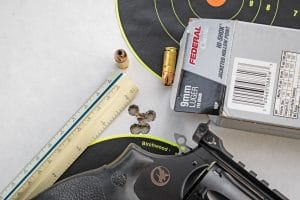Pulling the Trigger

My Lyman digital trigger pull gauge was set at the center of the trigger where the index finger normally rests. In double-action mode, average pull weight was over ten and a half pounds (10 lbs., 8.4 ounces, to be exact). It felt lighter to all of us who shot it. It’s a reasonably long pull, and that seems to distribute the weight better. The stabilizing weight of the massive barrel may also have helped make it seem lighter than it was.
Ten pounds sounds heavy to folks accustomed to striker-fired auto pistols and 1911s, but in fact, it’s not all that heavy for a double-action service revolver. The German engineers doubtless bore in mind that the mainspring would have to drive the hammer hard enough to reliably bust Magnum primers, and to light off some of the extremely hard primers we find in 9mm ammo that comes from offshore.
Single-action pull was a very clean and very consistent at 4 lbs., 5 oz. Again, with this chunky revolver, it felt lighter than it weighed out.
Bench Rest Testing
I didn’t expect a 9mm cylinder to do as well as the .38/.357 through a bore that allowed for the latter’s very slightly larger diameter. I turned out to be wrong.
With the .38/.357 cylinder, the first load up was Federal’s famously accurate Gold Medal Match 148-gr .38 Special target wadcutter. All five shots went into 1.05”, with the best three at 1/2-inch apart center to center. Winchester’s inexpensive “white box” generic .38 Special comprises the old USAF 130-gr. full metal jacket bullet at modest velocity, and is a hugely popular practice load. From the Nighthawk Korth Super Sport it put all five shots in 1.70”. The best three measured one-inch even, and hand-held from the bench rest, that’s a good predictor of what all five rounds would have done from a machine rest. For a .357 Magnum I chose that highly regarded man-stopper of yesteryear, the 125-gr. semi-jacketed hollow point. The scallop-jacketed Remington UMC bullets slammed in a group measuring 1.50” for all five hits, and 1.15” for the best three.

Next up was the 9mm cylinder. Three loads of known high accuracy were used, in three different brands and the three most popular bullet weights for the caliber. One shot strayed with Rem. UMC 147-gr. jacketed truncated cone, bringing the group to 1.95”; it would have been a 1.15” group if I’d kept it with the other four shots. The best three shots, however, were just half an inch: 0.55” center to center. For a 124-gr., I used SIG’s V-crown jacketed hollow point, resulting in a 5-shot group of 1.25 inches. Once again a single shot had ruined an outstanding group—the other four were in 0.75” and the best three, in 0.50”, which would have been linked by a single .45 caliber bullet hole. Finally, Federal’s great old 115-gr. JHP from their Classic series, product code 9BP, delivered the triumph of the day. All five shots were in a very uniform 0.65 inch.
Any gun that can let an old man with bad eyes shoot a group like that might just be worth all those thousands of dollars, after all.
Why was the Super Sport so accurate with both .38s and .357 Mags, with nominal bullet diameters of .357”, and slightly smaller 9mm bullets only .355” in diameter? Korth sizes the bore for the 9mm and, with polygonal rifling, expects the larger bullets to tighten into the rifling. The folks at Nighthawk tell me it does not increase pressure inside the gun to use the larger diameter .38/.357 bullets. Our testing showed that, conventional wisdom and expectation to the contrary, both the revolver cartridges and the auto pistol cartridges gave us excellent accuracy out of the same barrel.

Bottom Line
The Nighthawk/Korth Super Sport revolver is finely made, and it damn sure shoots! I would have loved to have shot it at Bianchi Cup or at a PPC match, but schedules did not allow.
There is, of course, the matter of price, but the premium for Korth workmanship (and Nighthawk customer service stateside) is, of course, an attractive selling point. And remember that ’66 Chevy, the “other” Super Sport we started this article with? Well, today one of those in good condition goes for about $25,000 or more. There ain’t gonna be a lot of these niche guns sold at this price, and rarity is a big factor in “investment guns.”
Check out the entire line of Korth/Nighthawk revolvers at your nearest dealer, or for more information, contact Nighthawk Custom; Dept. OT; Tel.: (877) 268-4867; Web : www.nighthawkcustom.com




















